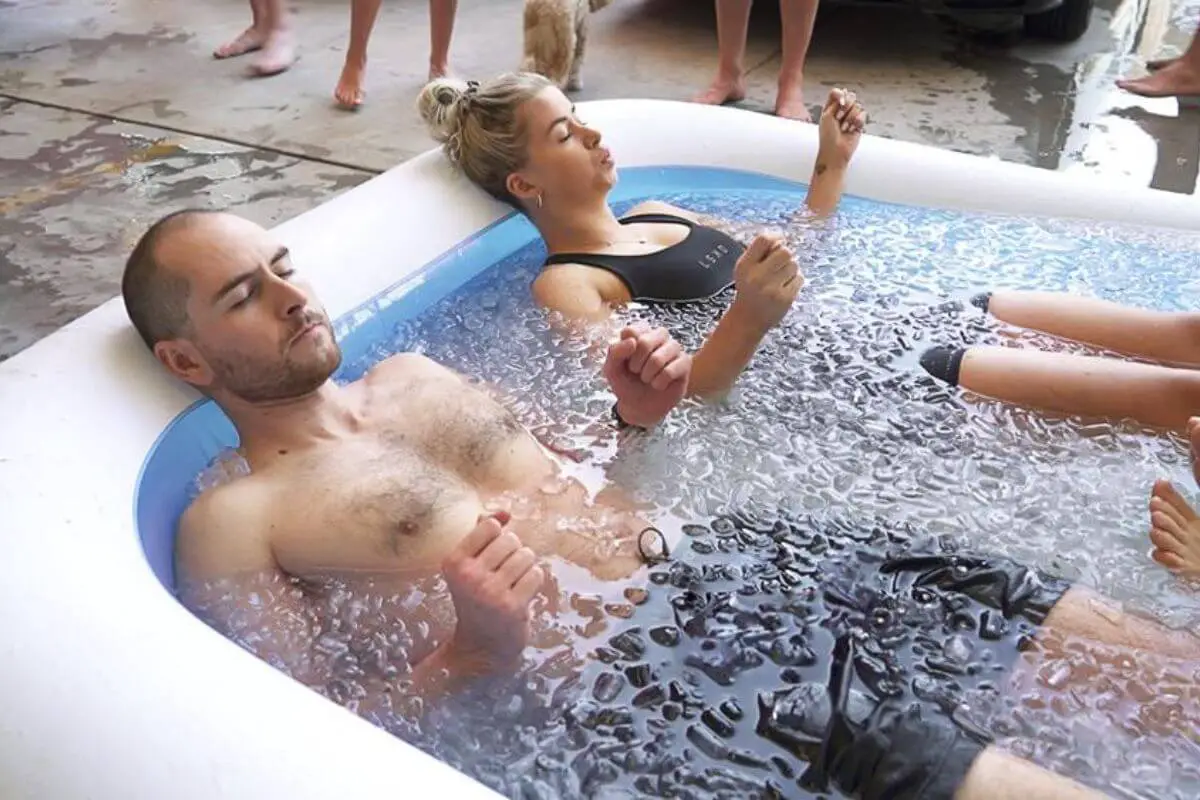Ice baths have gained popularity for their potential benefits, such as reducing muscle soreness and inflammation, enhancing recovery, and improving circulation. To create an effective ice bath, you need an ample supply of ice. Whether you’re an athlete, someone recovering from an intense workout, or just seeking the invigorating experience of an ice bath, this comprehensive guide will walk you through the steps to make plenty of ice for your ice bath at home.
Why Ice Baths?
Before we delve into making ice, let’s briefly explore the benefits of ice baths:
Muscle Recovery:
Ice baths are believed to help reduce muscle soreness and inflammation, making them a favorite among athletes.

Circulation:
Cold exposure can stimulate blood flow, potentially improving circulation and reducing muscle fatigue.
Improved Mood:
Ice baths can release endorphins and create a sense of euphoria and invigoration.
Enhanced Immune System:
Cold exposure may boost your immune system by increasing white blood cell count.
Preparing for Your Ice Bath
Here are the steps to ensure a successful ice bath experience:
1. Find a Suitable Container
- You’ll need a tub or container large enough to submerge your body comfortably. A bathtub works well, or you can use a large plastic container or a specialized cold tub if available.
2. Gather Supplies
- Collect your supplies in advance, including towels, a thermometer, a timer, and a change of warm clothing for after the bath.
3. Create a Safe Environment
- Ensure a safe environment by having someone nearby or letting someone know you’re taking an ice bath, as cold exposure can be challenging.
Maintenance and Long-Term Ice Bath Planning
Once you’ve experienced the benefits of ice baths and prepared an ample supply of ice, it’s essential to plan for the long term and maintain your ice bath routine effectively:
1. Consistency Is Key
- Ice baths are most effective when incorporated into a consistent routine. Consider how often you want to take ice baths, whether it’s after every intense workout, once a week, or on another schedule.
2. Gradual Adaptation
- As you continue your ice bath routine, your body may adapt to the cold. Gradually lower the temperature or increase the duration of your ice baths to challenge your body and achieve optimal benefits.
3. Recovery and Hydration
- Following an ice bath, focus on proper recovery techniques, including hydration, nutrition, and rest. These factors play a significant role in your overall recovery and performance.
4. Listen to Your Body
- Pay close attention to your body’s signals during and after ice baths. If you experience severe discomfort, dizziness, or shivering that doesn’t subside, discontinue the bath and seek warmth immediately.
5. Storage and Organization
- Keep your ice-making supplies well-organized. Ensure your freezer is clear and ready for continuous ice production. Having a designated area for ice trays and bags can simplify the process.
6. Ice Bath Accessories
- Consider investing in ice bath accessories such as thermometers, waterproof timers, and additional towels to enhance your ice bath experience.
7. Safety First
- Always prioritize safety and consult a healthcare professional if you have any concerns or underlying health conditions. Ice baths aren’t suitable for everyone, and individual tolerance can vary.
8. Seek Guidance
- If you’re new to ice baths, seek guidance from experienced individuals, coaches, or professionals who can provide insights into techniques and safety measures.
9. Measure Progress
- Keep track of your progress by maintaining a journal. Note the duration, temperature, and any changes in how your body responds to ice baths over time.
In Conclusion
Creating an effective ice bath experience at home involves more than just filling a tub with ice. By following the steps in this comprehensive guide, you can prepare an ample supply of ice and take full advantage of the potential benefits ice baths offer, from muscle recovery to improved circulation and mood enhancement. Remember to approach ice baths gradually, listen to your body, and maintain consistency in your routine. Always prioritize safety and seek professional advice if needed. Your ice bath journey can be both invigorating and rewarding when done with proper planning and care.
Maintaining Your Ice Bath Routine
Maintaining a regular ice bath routine can help you maximize the benefits and ensure a safe and enjoyable experience. Here are some tips for keeping your ice bath routine consistent:
1. Schedule Your Ice Baths
- Set a schedule that works for you. Whether you prefer to take ice baths after workouts or on specific days of the week, having a regular schedule makes it easier to incorporate ice baths into your routine.
2. Gradual Progression
- Over time, you can gradually increase the duration and decrease the temperature of your ice baths as your body adapts. This progressive approach can help you reap more benefits from the practice.
3. Monitor Your Progress
- Keep a journal to record your ice bath experiences. Note the temperature, duration, and how you feel before and after each ice bath. This can help you track your progress and make informed adjustments to your routine.
4. Stay Hydrated and Nourished
- After an ice bath, prioritize hydration and nutrition. Replenish your body with water and nutrient-rich foods to support recovery and overall well-being.
5. Incorporate Recovery Practices
- Complement your ice bath routine with other recovery practices, such as stretching, foam rolling, and massages, to enhance your overall recovery process.
6. Listen to Your Body
- Pay close attention to your body’s signals during ice baths. If you ever feel uncomfortable, dizzy, or experience prolonged shivering, exit the bath immediately and warm up.
Taking Your Ice Bath to the Next Level
Once you’ve established a consistent ice bath routine, you may consider taking your practice to the next level by exploring the following options:
1. Contrast Baths
- Contrast baths involve alternating between hot and cold baths to enhance circulation and recovery. After your ice bath, take a warm bath to experience the contrast effect.
2. Professional Guidance
- If you’re serious about incorporating ice baths into your training or recovery routine, consider seeking guidance from a sports therapist or professional who can provide personalized advice and techniques.
3. Group Sessions
- Ice baths can be a social activity. Consider organizing ice bath sessions with friends or teammates, as the group experience can add an element of camaraderie and motivation.
4. Cold Exposure Training
- Explore cold exposure training, such as the Wim Hof Method, which combines cold exposure with specific breathing techniques to improve the body’s tolerance to cold.
5. Experiment with Aromatherapy
- Enhance your ice bath experience by adding essential oils like lavender or eucalyptus to the water. The aromatherapy can provide relaxation and a soothing effect.
In Conclusion
Ice baths can be a valuable addition to your wellness and recovery routine when done with care and consistency. By maintaining your ice bath routine, monitoring your progress, and listening to your body, you can experience the potential benefits, from improved muscle recovery to enhanced circulation and mood. Remember that ice baths are not suitable for everyone, and individual tolerance can vary, so it’s essential to prioritize safety and seek professional guidance if needed. With dedication and a well-maintained routine, you can enjoy the invigorating and rewarding practice of ice baths.
Certainly, here are some frequently asked questions (FAQs) about taking ice baths and making ice for them:
FAQs
1. What are the potential benefits of taking ice baths?
Ice baths are believed to offer benefits such as reducing muscle soreness and inflammation, enhancing recovery, improving circulation, and even boosting mood and the immune system.
2. How do I determine the ideal temperature for my ice bath?
The recommended temperature for an ice bath typically ranges from 50°F to 59°F (10°C to 15°C). However, individual preferences vary, so it’s essential to find a temperature that feels challenging but bearable for you.
3. Can I make a large quantity of ice at once for my ice bath?
Yes, you can create a large supply of ice by using multiple ice trays and rotating them. This allows you to accumulate sufficient ice for your ice bath over time.
4. How often should I take ice baths?
The frequency of ice baths depends on your personal preferences and goals. Some individuals take them after intense workouts, while others incorporate them into their routine on specific days of the week. Find a schedule that works for you.
5. What should I do if I start shivering during an ice bath?
If you begin shivering uncontrollably during an ice bath, it’s a sign that your body is experiencing excessive cold. Exit the bath immediately and warm up using towels and warm clothing.
Remember that ice baths are a personal experience, and what works best for one person may differ for another. Always prioritize safety and tailor your ice bath routine to your needs and preferences.



